Summer fruits and vegetables are abundant and cheap right now; here’s how to preserve them.
At the end of every summer, my farm-life fantasies reach their peak. This is the easiest time of year to eat healthfully and deliciously. And knowing that the bounty of colorful produce will fade with the coming frost always spurs me to preserve as much of the season as I can.
Hi, I’m Melissa Clark, a columnist at New York Times Cooking, filling in for Jancee Dunn.
We’ve long known that eating a diet rich in fruits and vegetables is good for us. Summer fruits and vegetables are nutritionally dense and full of vitamins, minerals, antioxidants, flavonoids and all kinds of important anti-inflammatory compounds. And they’re at their best and most colorful right now, before the dun-colored monotony of potato season descends.
In my pastoral daydreams, I spend frenzied weeks pickling, canning, drying and jellying everything I can. But in my (busy) real life, I just slip a few essentials into the freezer. This is easy and gratifying, and a couple of weekend hours can set you up for the entire winter.
Below are some strategies for making hay while the sun still shines.
Tomatoes
More hydrating than watermelon, tomatoes have a range of nutrients, including antioxidents like lycopene, which has been linked to lower risks of certain cancers. The secret to saving summer tomatoes is to roast them and tuck them away in the freezer for a sweet, healthy alternative to canned tomatoes. (Added bonus: Cooked tomatoes are higher in lycopene than raw ones.)
Small tomatoes like cherry and grape tomatoes (left whole), and plum tomatoes (halved lengthwise) work best. Lay them out on a rimmed sheet pan and toss with olive oil, salt and any sturdy herbs you have around (thyme, oregano, sage, rosemary). Roast at 425 degrees until the tomatoes burst and turn golden at the edges. Cool and freeze in containers. Use them in sauces, soups and stews, such as this hearty, lemony white bean stew.
Zucchini
Removing moisture from zucchini and summer squash is the key to freezing them well. This takes some time on the stove, but it’s well worth it for the rich, caramelized flavors you get from cooking them down (and cooked zucchini takes up less space in the freezer). Grate a couple of pounds of zucchini, then slowly simmer it in salted olive oil (and butter if you like). Season with minced garlic and herbs, or leave plain. After about half an hour (stirring toward the end), it should look golden and condensed. Use in soups, dips and a lovely caramelized zucchini pasta on the coldest, dreariest days.
